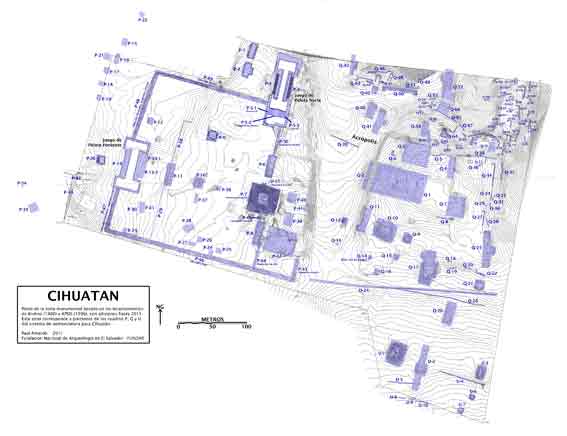Project Cihuatán News
2011-2012 Field Season
The activities of this season have included:
- Documentation and conservation of Structure P-9, whose excavation three decades ago went unreported.
- Analysis of cultural materials.
- Investigations in the sector of the Acropolis.
This season we started using a new system of nomenclature for Cihuatán's archaeological structures. This system was formulated in such a way as to preserve the existing "P" designations that have been used in publications since 1973. The new system imposes a grid with 500 x 500 meter squares (quadrats) over the entire site area. The squares are named alphabetically starting with "A". The structures in each square are named by its letter, followed by a hyphen and a sequential number. Most of the monumental structures are located in the "P", "Q" and "U" squares.
Map of Cihuatán's monumental zone. Click to see the map in greater detail.
Structure P-9
Structure P-9 is located in Cihuatán's great plaza, within its walled precint.
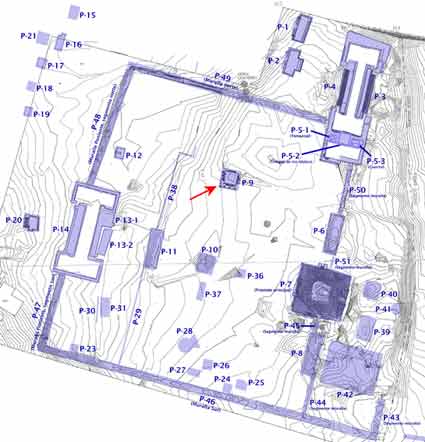
This small platform was excavated by William Fowler between 1978 and 1979. He offers the following commentary on this research in his unpublished thesis (1981):
“We mapped and excavated Structures P-1 and P-2 and the Southeast Patio…. We cleared the exterior of the North Ballcourt and the surface of Structures P-9, P-17, P-19, and P-20….”
This brief note is apparently the only information available on the excavation of Structure P-9. We are not aware of a report on this excavation, as is also the case for his excavations of Structures P-17 and P-19. Fortunately, the excavation of P-20 was described by other researchers (Hernandez 1975 and Lubensky 2005; both reports are available in the documents section of this website). Only very brief summaries (contained in his thesis) are known for the major excavations conducted by Fowler in the North Ball Court and the pair of temples designated as P-1 and P-2.
With regard to Structure P-9, there does exist a drawing made in 1979 by Manuel Mendez. Mendez was an assistant in the official Department of Archaeology assigned to participate in Fowler's investigations.
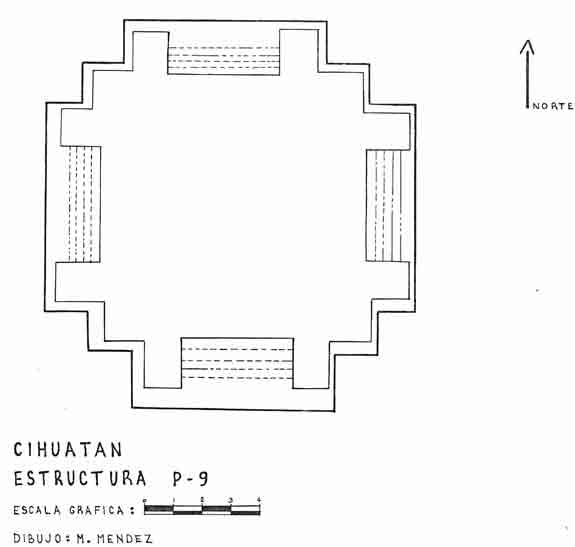
Mendez's drawing shows a platform with four stairways (with flanking balustrades). Our recent documentation differs in some details, and the platform is not oriented to the cardinal points, but rather according to an azimuth of approximately 12° as are many other buildings at Cihuatán.
This is the sum of the reported information about the excavation of the structure P-9.
Among the topics recorded in interviews with Jose Salguero (who oversaw Fowler's excavations) was description of the investigation of P-9. Keeping in mind the vagaries of oral history dating back three decades, Salguero said that P-9 was found in a relatively good condition, and still retained its "talpuja" facing blocks halfway up its tsides and steps. Talpuja is a common building material in Cihuatán, used for flooring and facing, and consists of mold-made blocks fabricated with "tierra blanca" (white volcanic ash), like adobe bricks but much more fragile due to the use of crumbly tierra blanca. Talpuja erodes very easily under normal rain and evidence suggests that anciently it was always covered with a layer of lime plaster. According to Salguero, Structure P-9, which was left exposed for decades, lost most of its facing as well as much of the volcanic field stone which formed its core. These stones tumbled down as rain eroded the earth morter holding them together.
Salguero also recounted that in mid-1980, when the region of Cihuatán became one of the most conflictive areas of the Salvadoran civil war, a group of army soldiers camped for several days in the monumental zone. They installed a large-caliber machine gun upon Structure P-9. They tore stones from the pavement found atop P-9 in order to improvise a little defensive wall around their position.
By 2011, this structure, having been excavated, eroded, and impacted by war, resembled a formless mound.
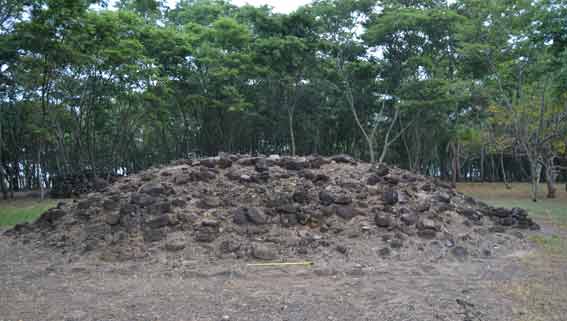
One of the activities of this season of the Cihuatán Project has been to document Structure P-9 and determine appropriate procedures for its preservation.
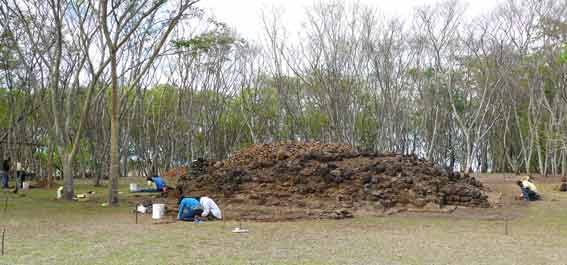
Students from the Universidad Tecnológica clean and document Sstructure P-9
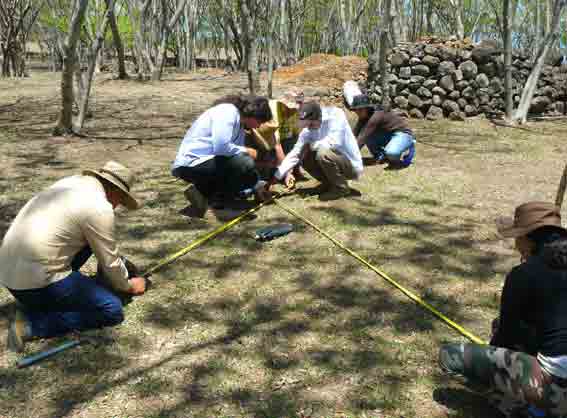
Laying out a grid.
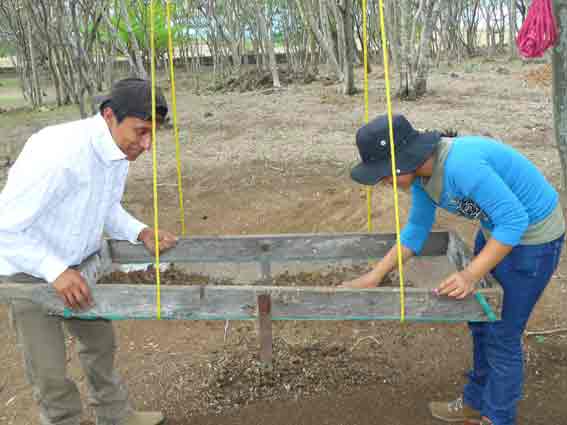
Julián Tolentino and Nancy Trujillo screening soil.
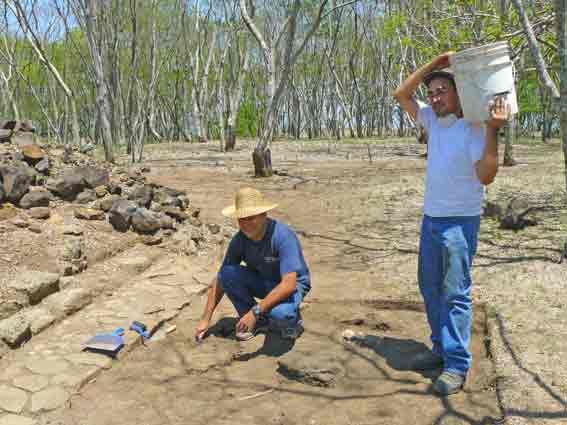
Leonardo Salazar and Edgar Cabrera clear off the lava pavement surrounding the structure.
Analysis of Materials
Work has continued on the analysis of the cultural materials found in investigations at Cihuatán, which mostly consist of potsherds. Karen Bruhns continued her work in ceramic classification , while Marshall Becker contributed to the reconstruction of several almenas from the royal palace. Marshall has a very extensive resume in Mesoamerican archeology, including research at Tikal and Copan.
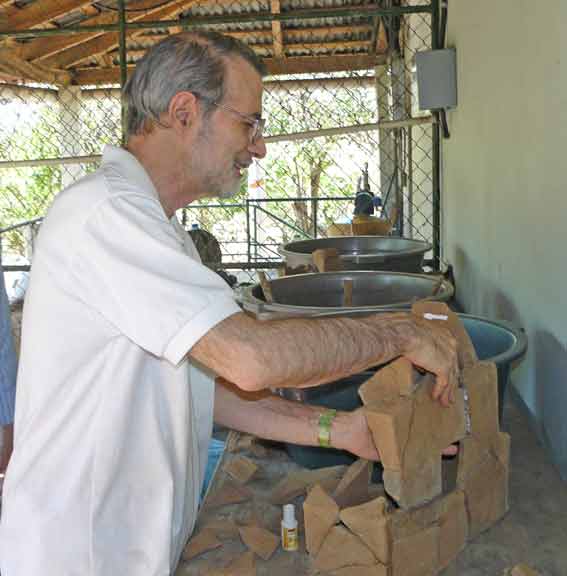
Marshall Becker reconstructs an almena from Cihuatán's royal palace. The almenas are generally found shattered in fragments strewn over an area of two or three meters (about six or nine feet).
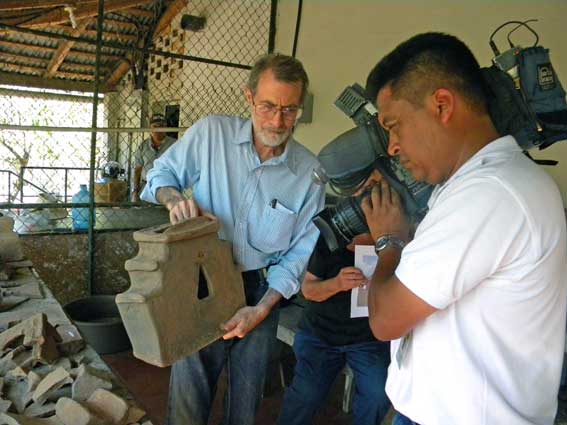
Marshall explains his work during a press conference at Cihuatán.

Karen Bruhns and Marshall Becker
Research in the Area of the Acropolis
The royal palace of Cihuatán is an extensive structure situated on the main body of the Acropolis. Previously, we sampled areas in its central portion and along its western, northern, and southern edges. During this season, we established its eastern limit.
An casual discovery prompted the investigation of Structure Q-40, located in the northwest sector of the Acropolis.
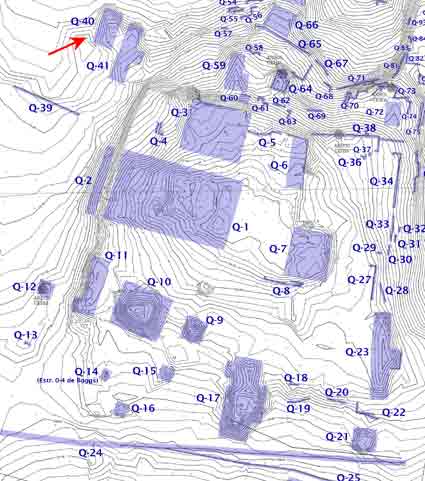
Prior to its excavation, Q-40 appeared to be an irregularly shaped platform. One of the park guards, Raúl Santos García, came across an unusual object exposed on the surface of this structure: a distinctive ceramic phytomorphic effgy (representation of a plant).
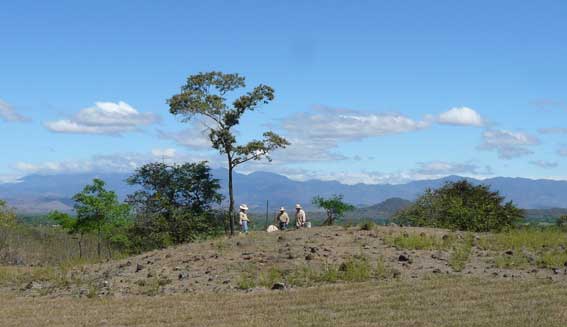
Structure Q-40 prior to excavation.

Raúl Santos García discovered the first phytomorphic effigy on the surface of Q-40.
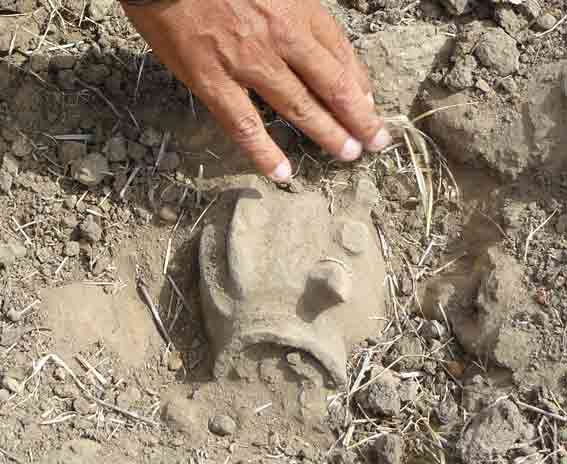
The first phytomorphic effigy as found.
We initiated an excavation to document the context of this object, and have now recorded a total of 20 effigies (several of them fragmentary), as well as fragments of incense burners associated with a T-shaped temple. The effigies appear to have been attached to the walls of the temple as architectural elements.
All the effigies are very similar. They have a hollow, more or less spherical body topped by a flaring rim. The body has three pairs of vertical ribs, alternating with three rows of curved spines. All of the specimens have a fractured base with two holes on opposing sides.
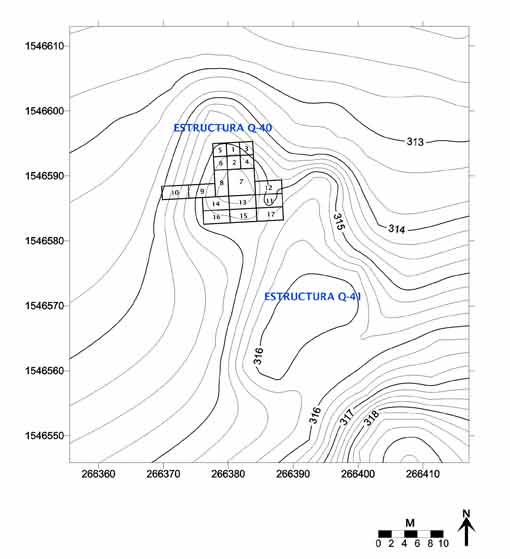
A detailed topographic map was made of Q-40 and its neighboring structues.
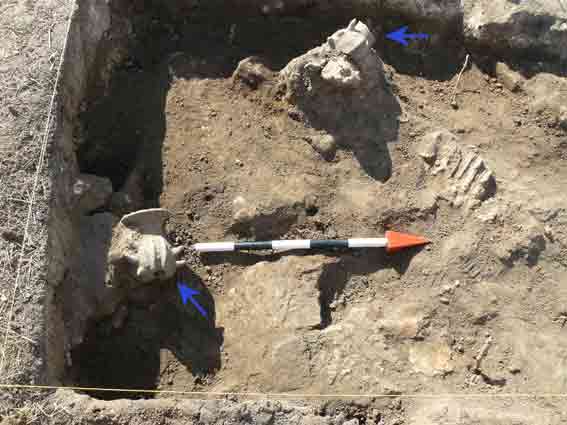
Excavation began centered on the exposed effigy (at the top of the photo, marked with a blue arrow). A second effigy appeared nearby (also marked with a blue arrow). Both effigies rested on a layer of burnt bahareque (wattle-and-daub) debris, including fragments of wall (the flat portions below the scale) and fragments with pole impressions (above the red arrow).
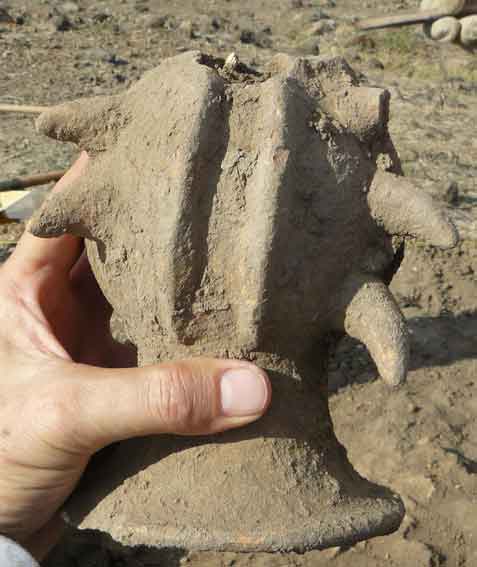
The second effigy.
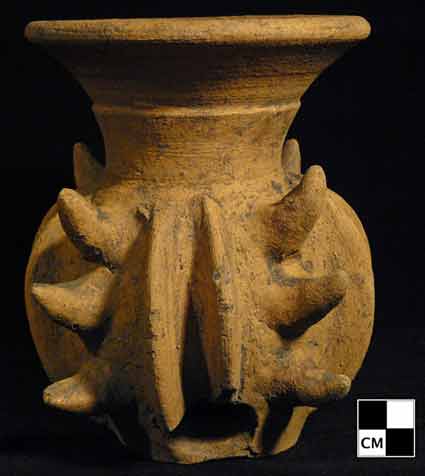
A phytomorphic effigy in what we believe to be its correct position, with its spines curving upward.
The remains of the temple on the platform indicate that it had walls made of adobe bricks and bahareque, sheltered by a thatched roof. The structure was burned, and we assume that this happened in the terminal event which the life of the city. A great deal of heat was generated by the burning roof, which collapsed and partially fired the bases of adobe and bahareque walls. This left dramatic archaeological evidence of destruction: a layer of charcoal from the roof, overlain by abundant fragments of burnt earth. A similar situation was briefly mentioned as being found in the excavation of another T-shaped temple (Structure P-2), but unfortunately beyond a brief summary there are no photographs or other information about that investigation.
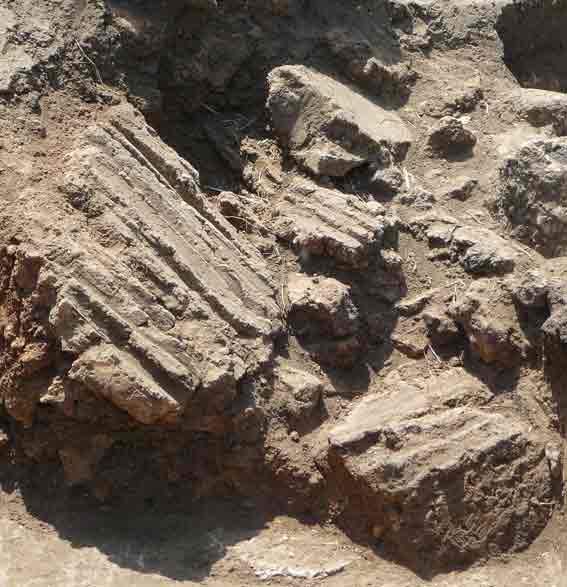
The thatched roof burned and partially fired the walls to a brick-like red. Its fragments include smooth wall faces and traces of poles
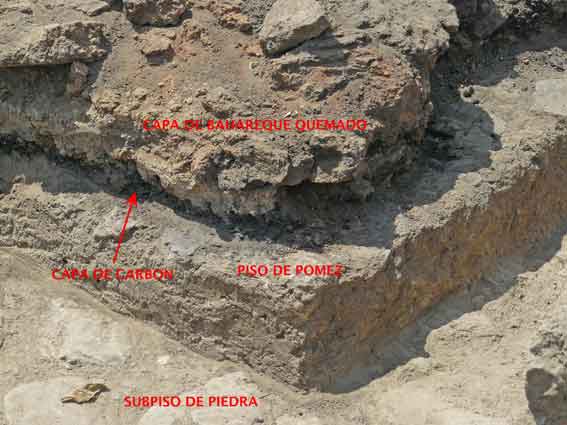
Bahareque fragments (labeled "capa de bahareque quemado" in the photo) fell upon a layer of charcoal ("capa de carbón") which is in direct contact with a pumice floor ("piso de pómez"). As in several other structures at Cihuatán, this floor was built of pumice cobbles with their facing side carefully crafted as a flat surface. Also common is the use of a rougher subfloor ("subpiso de piedra"), to level and create a firm base, over which was desposited a layer of compacted earth and finally the pumice floor.
Two construction stages are visible in the temple's stairway. The first was faced with tabular elements of talpetate (volcanic tuff), and the second was covered with blocks of the fragile material known as "talpuja" (like adobe bricks, but made of white volcanic ash). The second stage is poorly preserved. There was a third stage of construction - apparently interrupted by the destruction of Cihuatán - during which fill was being deposited in order to join this temple with neighboring Structure Q-41.
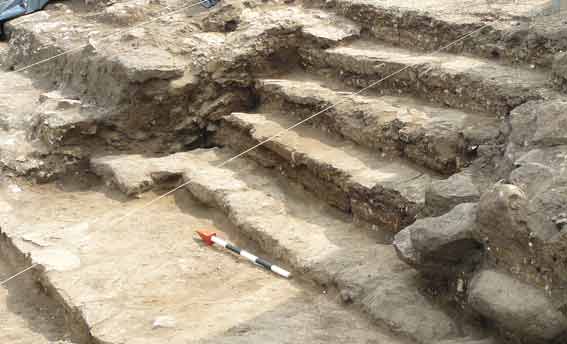
The stairway of Structure Q-40 has two construction phases. The first was made of talpetate (volcanic tuff) and is in relatively good condition, while the second, made mostly of talpuja, is nearly destroyed.
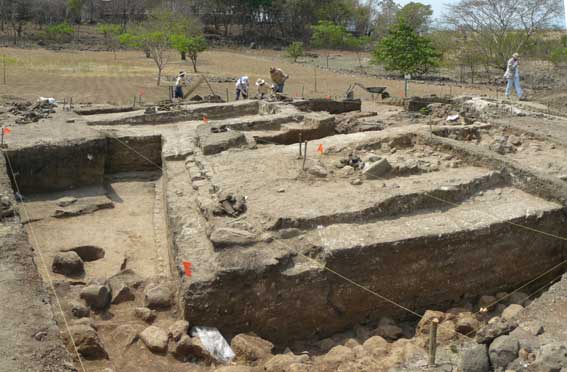
View of the southeastern portion of Structure Q-40, where there is evidence of a third stage of construction. The sides of the platform are faced with talpuja blocks. The stones visible at the bottom of the picture represent a final unfinished activity that was interrupted when the temple was destroyed, in which fieldstone and earth were being desposited in order unite it with neighboring Structure Q-41.
There were small fragments of at least two spiked incense burners scattered over the stairway, and several larger fragments at its foot. They belong to a type characteristic of Cihuatán and affiliated sites, called Las Lajas censers. As at Structure Q-40, broken censers have been found on or near the stairways at other temples excavated in Cihuatán.

Fragments of spiked censers at the foot of the stairway located on Structure Q-40's western side.
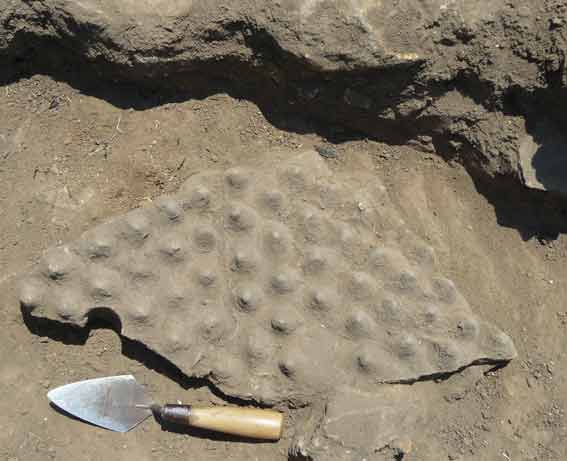
Some incense burners of this type stood as tall as 1.5 meters (nearly 5 feet) and had an hourglass-shaped silhouette. They contained an internal disk insert, located above their narrow "waist", which supported the glowing embers upon which incense was scattered. This fragment shows the hole that allowed the disk to be tilted and lifted out (using a stick) in order to dispose of accumulated ash.

By virture of their large size, these censer broke into many fragments. We found several large pieces on the presumed contemporary ground surface in front of the steps, but some sherds were deposited considerably later, as evidenced by the thickness of the accumulated soil between from the large fragment in this photo and the overlying sherd (with spikes), and between the spiked sherd and the small fragment on the very top.
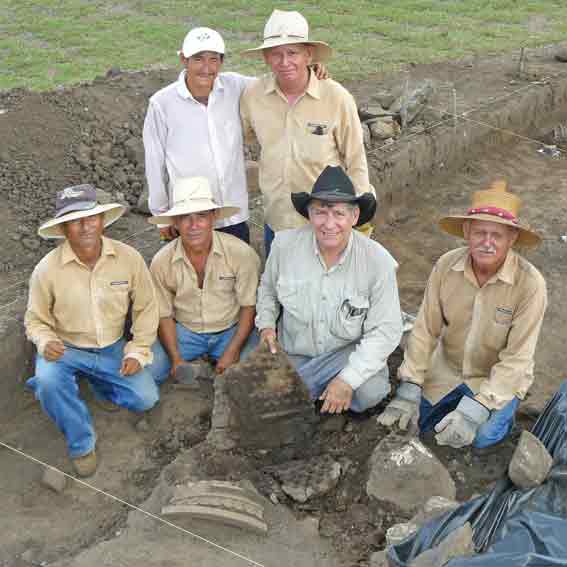
Part of the crew removing censer fragments. Standing: Miguel Angel Pineda and Antonio Castillo. Kneeling: Miguel Angel Pineda Pineda, Rutilio Castillo, Paul Amaroli, and Pastor Gálvez.

The exterior (top) and interior (bottom) of the largest censer fragment (the same being held in the previous photo). To finish these huge ceramic objects, the surfaces were roughly smoothed using a corn cob, leaving parallel striations still visible on the interior. The suface was then smoothed with a damp cloth and fingers, erasing much of striations. At that point the exterior received appliques to form its spikes, rims, and disks.
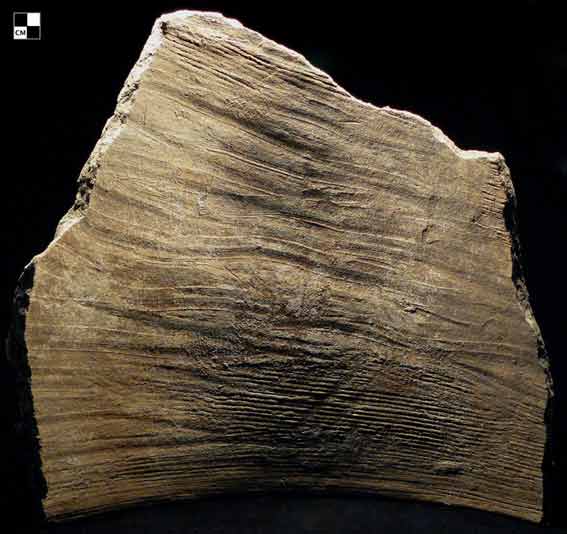
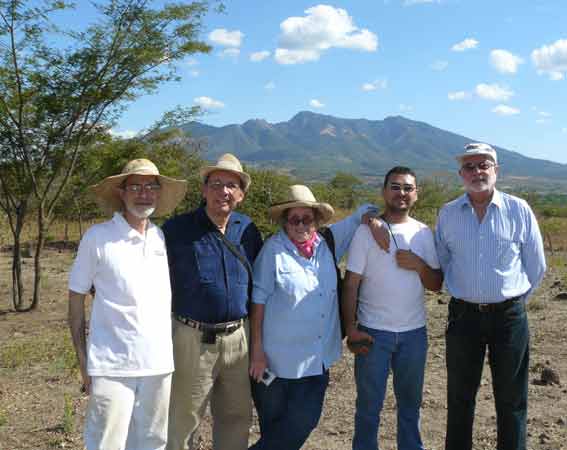
The team this season has included (from left to right), Marshall Becker, Carlos Payés (Secretary, FUNDAR), Karen Bruhns, Edgar Cabrera (student, Universidad Tecnológica) and Rodrigo Brito (President, FUNDAR).

From left to right, Marshall Becker, Paul Amaroli, Rodrigo Brito, and Ramón Rivas (Director Nacional de Patrimonio Cultural of the Secretaría de Cultura through March, 2012).
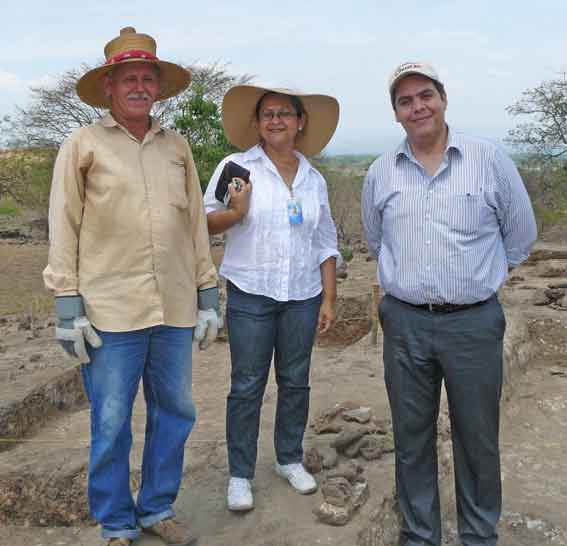
In an official visit, from right to left, Gustavo Milan (Director Nacional de Patrimonio Cultural), Irma Flores (Advisor to the Dirección Nacional de Patrimonio Cultural), and Pastor Gálvez (Cihuatán Park Manager).
Structure Q-40 and its Enigmatic Phytomorphic Effigies
The phytomorphic effigies found at Structure Q-40 are known only from Cihuatán and apparently some affiliated sites
Fowler (in his thesis) mentions the presence of fragments of similar objects in Cihuatán and Santa Maria, a site now inundated in the Cerron Grande reservoir (also known as "Lake Suchitlán"), but without mentioning their context or provenience within these sites. He illustrates a more or less complete specimen which apparently was not found in his excavations, but again does not describe its context or provenience. The Hanaía collection (Sonsonate) had a copy attributed to the Tacuscalco site (Nahulingo). Tacuscalco was a major Pipil community at the time of the Spanish conquest, and its occupation reaches back to the Preclassic period; however, its possible cultural affiliation with Cihuatán (during the Early Postclassic period) has yet to be demonstrated. Yet another similar effigy (unprovenienced) is on display at the Museum of Anthropology at the Universidad Tecnológica (San Salvador).
The excavation of Structure Q-40 has resulted in a large collection of these effigies, for the first time with archaeological context. They were associated with a temple that was burned to the ground, in all likelihood during the attack which destroyed Cihuatán. That this was an important temple is suggested by its location - practically in the shadow of the royal palace - and by the fact that it had three construction stages, something up to now unique in Cihuatán's architecture.
The information gleaned from this research promises to lead to new interpretations of these effigies, which could contribute to a better understanding of the ideology and origins of the Cihuatán's ancient inhabitants.
